# EDDP - Leipzig Airport
# Overview
### Leipzig ATC Stations
| **Station**
| **Station ID**
| **Login**
| **Frequency**
| **Remark**
|
| **ATIS** | PX | EDDP\_ATIS | 123.955 | |
| **Delivery**
| PL
| EDDP\_DEL
| 121.680
|
|
| **Ground** | PG
| EDDP\_GND
| 121.805
|
|
| Tower North | PTN
| EDDP\_N\_TWR
| 125.955
|
|
| **Tower South**
| PTS
| EDDP\_S\_TWR
| 121.105
|
|
| **Arrival**
|
| München Radar
(Thüringen Low North)
| TRN
| EDDP\_TRN\_APP
| 126.065
|
|
| **München Radar**
**(Thüringen Low South)**
| TRS
| EDDP\_TRS\_APP
| 126.175
| Covering sector SAS (Sachsen Low) if not staffed
|
| Feeder North "Arrival"
| DPND
| EDDP\_ND\_APP
| 120.840
|
|
| **Feeder South "Arrival"**
| DPSD
| EDDP\_SD\_APP
| 129.765
|
|
# Delivery
### Responsibilities
Leipzig Delivery is responsible for issuing IFR enroute clearances and startup approval.
### SID Assignment
- Aircraft on Aprons 2 and 4 usually get the southern runway
- Aircraft on Aprons 1 and 3 usually get the northern runway
- The aircraft types A346/B77W/B744/B748/A388 are prefered for the southern runway
|
| **DRN** | **GOLAT** | **NEVKO** | **ORTAG** | **PENEM** | EDDP | **CLIMB** |
| **26R** | **2N** | **2N** | **2N** | **5N** | **1N \*** | 1N | **FL 070** |
| **26L** | **1L**
2S **\***
| **2S** | **2S** | **5S** | **1S \*** | 1S |
| **08R** | **2E** | 1K **\***
**2E**
| 1K **\***
**2E**
| **5E** | **1E** | 1E |
| **08L** | **2Q** | **2Q** | **2Q** | **5Q \***
1X
| **1Q \***
1X
| 1Q |
- **\*** Climb via SID
- **Marked** are preferred
- Day Departures only (0600 lcl - 2200 lcl)
- MTOW below 136 tons only
- EDDP Departures are omnidirectional - for NON-RNAV equipped aircraft only!
### Invalid routes (re-clearances)
If a pilot has filed an invalid route but can fly the latest SIDs, these re-routes shall be used:
- - RUDAK --> PENEM Y236 RUDAK
- ODLUN --> PENEM Y233 ODLUN
- UMBAL --> PENEM Z131 UMBAL
- MAG --> PENEM Y233 ODLUN Z207 MAG
### Datalink Clearance (PDC/DCL)
Leipzig/Halle Airport has a Datalink Clearance System. EDDP is to be used as the log-in code.
# Ground
Leipzig Ground is responsible for all taxiing traffic on the aprons and taxiways, as well as pushbacks.
### Taxiways Apron 4
The taxiways at Apron 4 (DHL Apron) are called "Blue" or "Orange" Line despite their designation. The respective bays are internally referred to as A-bay, B-bay, ..., E-Bay.
| **Bay** | **Taxiway 1** | **Callsign** | **Taxiway 2** | **Callsign** | **Taxiway 3** | **Rufname** |
|---|
| **A-Bay** | Z1.1 | Z1 orange | Z1.2 | Z1 blue | - | - |
| **B-Bay** | Z2.1 | Z2 orange | Z2.2 | Z2 blue | - | - |
| **C-Bay** | Z3.1 | Z3 orange | Z3.2 | Z3 blue | - | - |
| **D-Bay** | Z4.1 | Z4 orange | Z4.2 | Z4 | Z4.3 | Z4 blue |
| **E-Bay** | Z5.1 | Z5 orange | Z5.2 | Z5 | - | - |
These taxiways are usually not used on frequency. **To avoid conflicts, they shall be given anyway!**
Departing aircraft push to the nearest taxiway within the bay according to their wingspan.
####
### Taxiway restrictions
| ##### **Taxiways/Holdinspoints/Apron**
| ##### **Restrictions**
|
| Taxiways M und H2 | Max. wingspan 52 m
|
| Taxiway L between Stands 101-111 | Max. wingspan 36 m
|
| Taxiway S6 | Turning westbound onto taxiway T is prohibited
|
| Apron 4 | - Taxiways: Z1.1, Z1.2,Z 2.1, Z2.2, Z3.1, Z3.2, Z4.1, Z4.3, Z5.1 max. wingspan 52 m
- Simultaneous use of Z4.2 with Z4.1/Z4.3 is prohibited, the same applies to Z5.2 and Z5.1
|
| Taxiway V (between S2 and Y) | Max. wingspan 65 m
|
| Holdingpoints S1-S10 | No taxiing behind it on taxiway T possible at the same time
|
| Holdingpoints A1, A2 | - No traffic on both taxiways at the same time (CATI)
- No simultaneous traffic on both taxiways if the wingspan of one aircraft is more than 52m (CATII/III), but this only applies if the second traffic is taxiing from taxiway C to A2
|
| Holdingpoints A8, A9 | No traffic on both taxiways at the same time if the maximum wingspan of an aircraft exceeds 52m
|
Map following shortly :) .
### Gate Assignments
#### Apron 1
The passenger terminal and the GAT are located on apron two. All passenger and sports aircraft are parked here.
| **Stands** | **Usage** |
|---|
| **101 - 111** | Airlines; aircraft that do not require a jetway |
| **112 - 121** | Mainly business jets and private aircraft |
| **126 - 130** | Airlines (Schengen); aircraft that require a jetway |
| **132 - 136** | Airlines (non-Schengen); aircraft that require a jetway |
| **137 - 143** | General Aviation (GAT) |
At stands 101-111, aircraft are usually parked with their nose to the south. Thus they are taxi out stands. Aircraft with their own stairs (e.g. CRJ) are also parked at stand 130 and handled by "walkboarding"
#### Apron 2
Apron 2 is mainly used by cargo aircraft that do not fly in the DHL network, but in some cases also by aircraft from the DHL Group. Parking stands are available for every aircraft category.
#### Apron 3
There is a parking area and a hangar for aircraft of the airline Volga-Dnepr-Airlines.
The virtual airline "Leipzig Air" also has a fictional apron here. This is not available in the ground layout and is only released when explicitly requested by the pilot.
#### Apron 4/5
Only aircraft operating flights within the DHL network park on apron 4. There are several parking positions for each aircraft type. There are also restrictions for some parking positions due to the maximum authorised wingspan of the aircraft. All restrictions are implemented in the latest version of the Groundradar plug-in.
The following airlines mainly fly to Leipzig as part of the DHL network:
| ICAO-Code | Airline | Callsign |
|---|
| **ABR** | ASL Airlines Ireland | CONTRACT |
| **BCS** | European Air Transport | POSTMAN |
| **BOX** | AeroLogic | GERMAN CARGO |
| **CKS** | Kalitta Air | CONNIE |
| **DHA** | DHL Air Austria | YELLOW TAIL |
| **DHK** | DHL Air UK | WORLD EXPRESS |
| **DHX** | DHL Middle East | DILMUN |
| **GTI** | Atlas Air | GIANT |
| **MNB** | MNG Airlines | BLACK SEA |
| **PAC** | Polar Air Cargo | POLAR |
| **SOO** | Southern Air | SOUTHERN AIR |
| **SOP** | Solinair | SOLINAIR |
| **SRR** | Star Air | WHITESTAR |
### High Intensity Runway Operation (HIRO)
At night (between 2200lcl and 0600lcl) all B752/A306/B763 on the southern runway are expected to vacate via S6 (RWY08L) or S4 (RWY26L). Aircraft that are parking on Apron 4/5 will vacate via S6/S4 cross T and hold short of V unless otherwise instructed by Tower (this only applies during HIRO).
Be careful when assigning intersection H5 with runway 26 in operation, as nose-to-nose conflicts can quickly develop here if an arriving aircraft vacates and a departing aircraft taxies onto the intersection.
If you are unsure whether you can assign the intersection, coordinate with the tower controller as he can instruct the arriving aircraft to vacate later if necessary.
The same applies during HIRO operations on taxiway V and T, as the traffic vacates, crosses T directly and holds short of V without having to contact ground, which can easily lead to cleared conflicts.
# Tower
### Tower positions
In Leipzig there are the following two tower positions:
| **Station** | **Station ID** | **Login**
| **Frequency**
|
| Tower North
| PTN
| EDDP\_N\_TWR
| 125.955 |
| Tower South
| PTS
| EDDP\_S\_TWR
| 121.105
|
If both tower positions are staffed, the CTR is split in half in the middle, parallel to the runways. The north tower is responsible for the northern half of the CTR, the south tower for the southern half.
If only one tower is staffed, it also takes over the duties of the other tower and **cross couples both frequencies**.
### Departing traffic
Leipzig Tower receives all departing aircraft at the holding point. Once they are airborne they have to be handed over manually to the corresponding departure frequency:
| 126.065 | 126.175 |
| PENEM | NEVKO |
| ORTAG | GOLAT
|
| - | DRN
|
There is an exception for parallel departures (lateral distance less than 3 NM), where the handover only takes place as soon as one of the departures turns away from the extended centerline.
#### Parallel departures
To use parallel departures the following criteria must be met:
- All aircraft are flying a published departure procedure
- It must be ensured that the departure routes do not cross! Coordination with the other tower is ecessary!
- Leipzig Tower must ensure that all involved aircraft do not turn before the published turns in the departure procedure. If one aircraft deviates from the extended centerline before the published turn, it and all other aircraft, that are closer than 3NM have to be turned away from the extended centerline immediately!
- Both aircraft are handed over to the departure frequency once one of them turns away from the extended centerline (or the radar seperation is given) as published in the departure procedure.
It is possible that aircraft with a good climb performance reach theirn initial climb (FL70) before one of them turns away from the extended centerline. To prevent an aircraft from levelling out, you can request a higher level from the responsible approach controller.
S\_TWR always needs a release from N\_TWR for departures to the north (ORTAG, PENEM)
N\_TWR always needs a release from S\_TWR for departures to the south (NEVKO, GOLAT, DRN)
### Arriving traffic
Leipzig Tower receives all arriving aircraft one of the published approach procedures unless otherwise coordinated (e.g. visual approach). When the aircraft vacates the runway, they must be handed over to the ground controller.
#### RECAT-EU procedures
Leipzig is one of the airports at which the DFS approved the use of the RECAT-EU procedures.
**The use of them is only allowed for the category "Lower Heavy/Upper Heavy" and "Lower Heavy/Lower Heavy", these are the aircraft types: **
| ##### **Upper Heavy**
| ##### **Lower Heavy**
|
| **A330** | **A300** |
| **A340** | **A310** |
| **A350** | **B703** |
| **B747** | **B757** |
| **B777** | **B767** |
| **B787** | **B783** |
| **IL96** | **C135** |
|
| **DC10** |
|
| **DC85** |
|
| **IL76** |
|
| **MD11** |
|
| **TU22** |
|
| **TU95** |
According to the procedure 2 of the above aircraft types only have to be separated 3NM (wake turbulence) unless another method of separation (e.g. radar separation) requires more.
The pilot can refuse this procedure at any time, but shall inform you early.
Caution between Upper-Heavy and Lower-Heavy! The "Lower Heavy" must be preceding!
Mediums are excluded from this procedure!
Fore more information: [Eurocontrol](https://www.eurocontrol.int/sites/default/files/2021-07/recat-eu-released-september-2018.pdf)
#### Modes of Operation
he mode of approach is specified by the approach controller and coordinated to the tower.
Leipzig is authorised for the use of the following types of separation between aircraft on different finals:
Independent parallel approaches
When using independent parallel approaches both finals are completely independent.
To use parallel independent approaches, the following criteria must be met:
- Both Tower and Director positions must be staffed
- All aircraft involved must use precision approaches (the only precision approach that is available in Leipzig is the ILS approach)
- If an aircraft deviates from the final approach path, it and any other aircraft on the adjacent approach that is closer than 3NM from the deviating aircraft must be turned away from the final approach path immediately even if they are below the MVA!
Consider independent operations and ensure separation or non-persition approaches!
Dependent parallel approaches
When using dependent parallel approaches 2 aircraft on different finals must be seperated at least 1,5NM. If the separation becomes less than 1,5NM it counts as a loss of separation which has to be resolved immediately.
To use parallel dependent approaches, the following criteria must be met:
- At least one Director position must be staffed
- All aircraft involved must use precision approaches (the only precision approach that is available in Leipzig is the ILS approach)
- If an aircraft deviates from the final approach path, it and any other aircraft on the adjacent approach that is closer than 3NM from the deviating aircraft must be turned away from the final approach path immediately even if they are below the MVA!
Staggered approaches
When using staggered approaches all aircraft under IFR on any approach have to be separated at least 3NM to any other aircraft under IFR on the adjacent approach
Segregated parallel operations
When using segregated parallel operations one runway is used exclusively for arrivals and the other one exclusively for departures. This mode of operation decreases the amount of traffic that can be handled and thus might seem unnecessary. If it is used during LVP it actually makes sense and increases the amount of traffic that can be handled.
**Staggered approaches are preferred**, but there is no reason not to use other modes of operation if the required criteria are met!
### Preferred operating direction
The preferred operating direction is 26 up to a tailwind component of 5 knots. High-altitude winds must also be taken into observation.
### Control zone
The Leipzig control zone extends roughly between the cities of Halle and Leipzig. The vertical limit of the CTR is 2500ft MSL. Entry and exit into the control zone is via the mandatory reporting points:
- North: November 1/2
- South: Sierra 1/2
Traffic circuits should not be authorised between the runways.
[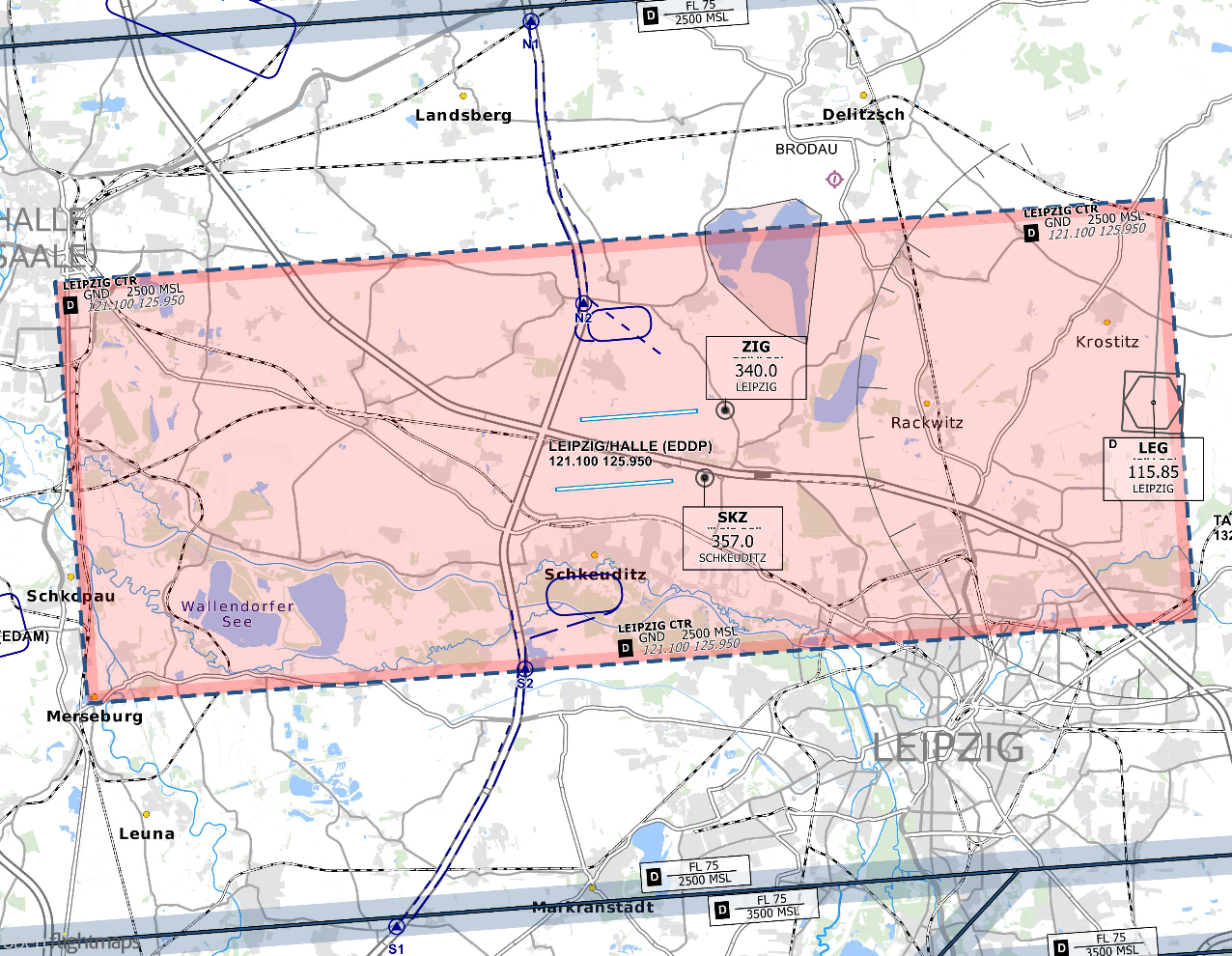](https://knowledgebase.vatsim-germany.org/uploads/images/gallery/2022-09/eddp-ctr.png)*Controllzone Leipzig - © [openflightmaps.org](https://www.openflightmaps.org/)
*
Handovers between the towers should take place between the runways. A transfer point (e. g. circling) would be the tower.
#### High Intensity Runway Operations (HIRO)
Due to the higher traffic volume at night, pilots are expected to vacate the runway between 2200lcl and 0600lcl via the following high-speed taxiways:
| **Aircraft type** | **Runway 08R** | **Runway 26L** |
|---|
| B752 / A306 / B763
ALL MEDIUM (Jet and Prop)
| **S6** (2550m/7382ft) | **S4** (1850m/6070ft) |
Aircraft parked at Apron 4/5 cross taxiway T and shall hold short of V.
### Low Visibility Procedures (LVP)
In Leipzig, the ILS is authorised for all runways up to CATIIIb.
During low-visibility operations, single-use of runway OPS shall be used (egregated parallel operations); individual approaches may deviate from this.
To broadcast the information via ATIS that LVP are active, the ATIS maker URL is supplemented by "&lvp", which appears in the ATIS:
> LOW VISIBILITY PROCEDURES IN OPERATION CAT II AND III AVAILABLE
### Scenery problems
In the flight simulators, there are sometimes differences in the various sceneries compared to the Euroscope ground layout. The biggest problem here is the old southern runway, which is still present in the FSX default scenery. It runs parallel to taxiway N between H1 and H5. Furthermore, the old southern runway minimally intersects the new runway. In such cases, you should assign the north runway to the pilots, as this is displayed correctly in all simulators.
# Arrival - Thüringen Low
### Sectorization
München Radar sectors **Thüringen Low Nord** and **Thüringen Low Süd** (EDDP\_TRN/TRS\_APP) are responsible for all arrivals and departures from/to **Leipzig/Halle (EDDP)** and **Erfurt-Weimar (EDDE)**.
Additionally, the station EDDP\_TRS\_APP covers sector Sachsen Low (SAS), handling all movements at Dresden (EDDC).
Requirement for staffing the sectors is proficient knowledge of the SOPs for airports EDDP, EDDE and EDDC, as top-down service shall be provided at those airports. Besides those controlled airports, the uncontrolled airfield Leipzig-Altenburg (EDAC) lays within the sector, offering IFR procedures and is therefore sorrounded by a RMZ.
It is possible to staff two additional stations within Leipzig TMA for delegating Director tasks to separate stations: Leipzig Arrival Nord/Süd (EDDP\_ND/SD\_APP) which do not hold a sector themselves but receive a full release for traffic being sent to them.
The sector dimensions and divisions for the approach sectors underlying EBG Ost are shown in this chart:
[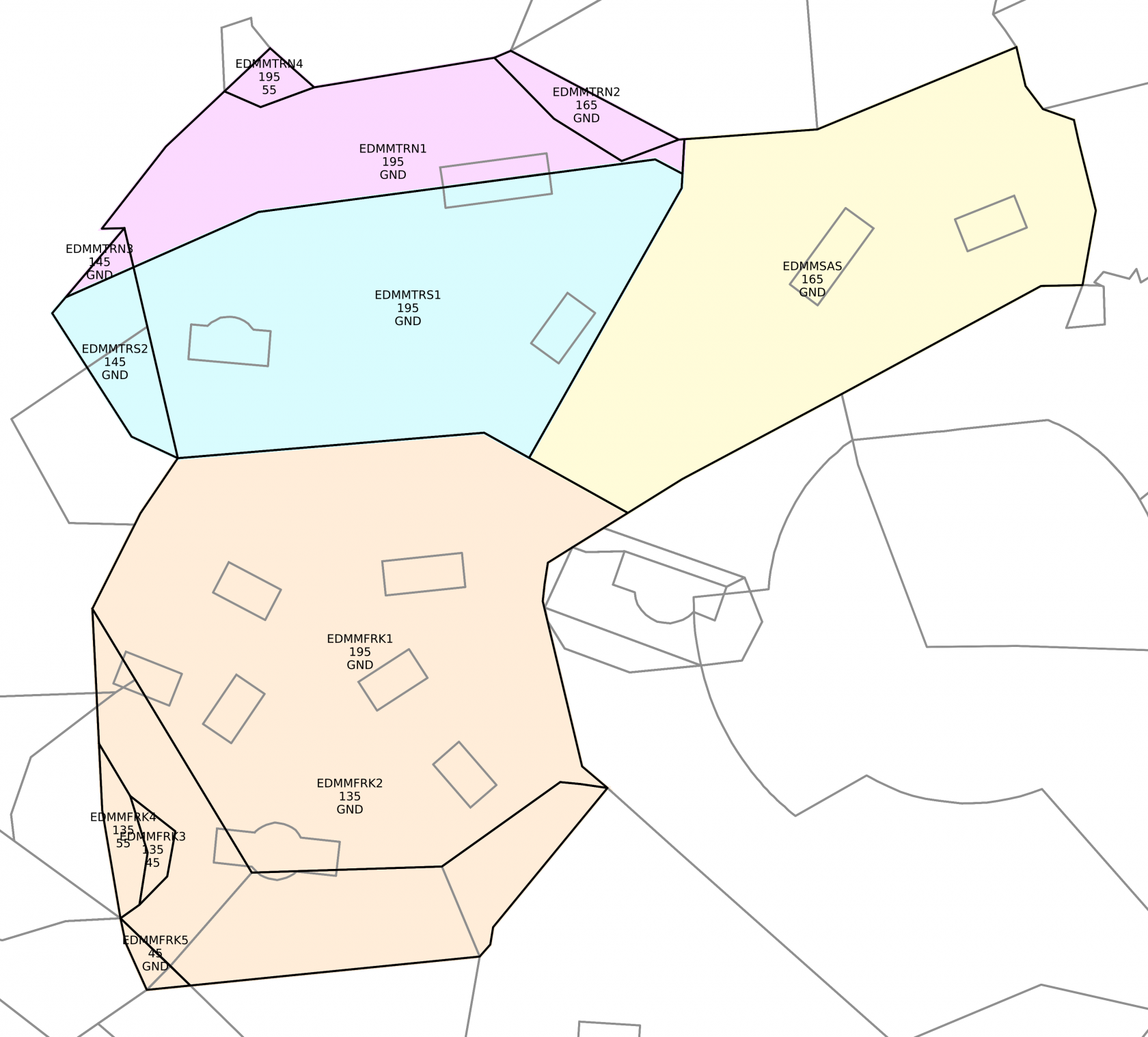](https://knowledgebase.vatsim-germany.org/uploads/images/gallery/2024-12/sectors-edmmost-low.png)
*Approach sectors underlying EBG Ost*
### Airspace
#### Leipzig/Halle (EDDP)
Around Leipzig/Halle, Airspace D (non-CTR) is established up to FL75. Between FL75 and FL100, in the Airspace E band, an additional TMZ is established. VFR traffic is expected to squawk 4404 and monitor 126.175 (EDDP\_TRS\_APP).
Both Airspace D and the TMZ Leipzig consist of always-active parts, and HX parts that are active depending on the operating direction (26 – east active, 08 – west active).
IFR traffic should be kept within protected airspace during daytime. Speed restrictions of Airspace D (≤250 kt) may not be lifted.
[](https://knowledgebase.vatsim-germany.org/uploads/images/gallery/2022-09/eddp-approach-luftraum.png)*Airspace around EDDP. Source: Openflightmaps*
#### Erfurt-Weimar (EDDE)
Erfurt-Weimar is surrounded by Airspace E, and TMZ(HX) Erfurt, activated for IFR traffic on demand. The TMZ code is 4410, and VFR traffic is expected to monitor 126.175 (EDDP\_TRS\_APP).
[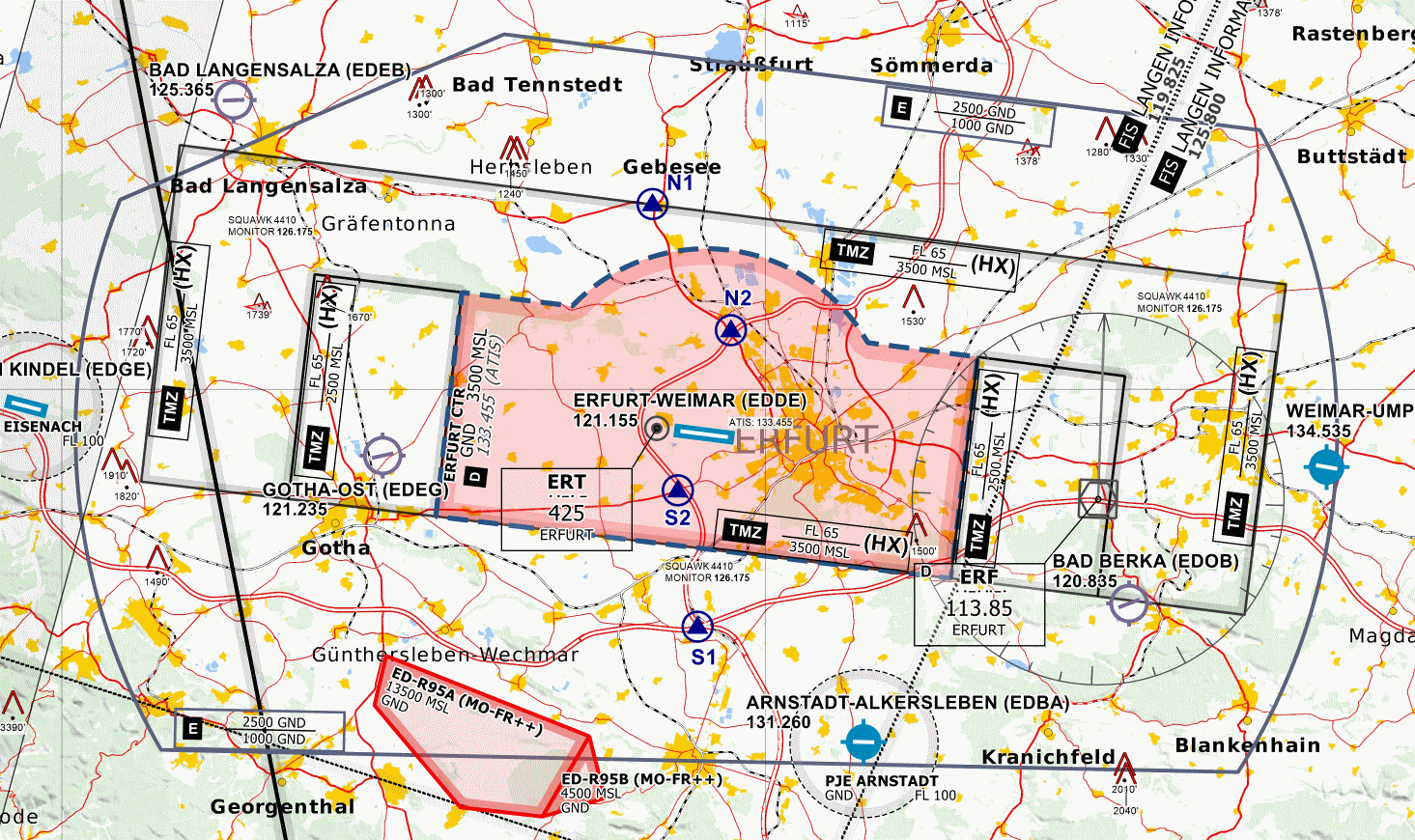](https://knowledgebase.vatsim-germany.org/uploads/images/gallery/2022-09/edde-luftraum.png)*Airspace around EDDE. Source: Openflightmaps*
## Departing traffic
#### Leipzig/Halle
Traffic is handed off to München Radar in their first procedure turn (SID or OID), when proper separation is established.
The speed limit for Airspace D (250 kts) shall not be cancelled.
Departing aircraft may always be cleared to the last waypoint of the SID. Particular attention should be paid to potential conflicts in the Sachsen Low.
#### Erfurt-Weimar
Departures from Erfurt must be coordinated individually with the tower before take-off. The reason for this is the short distance to the sector boundaries of EDGG\_HEF\_CTR and EDDN\_FRK\_APP.
#### Handovers
Thüringen Low hands over departing aircraft from Leipzig as follows:
| **Sektor** | **Wegpunkte** | **Übergabehöhen** |
| **Gera** (EDMM\_GER\_CTR) | NEVKO, GOLAT | FL190 |
| **Halle** (EDMM\_HAL\_CTR) | ORTAG | FL190 |
| **Sachsen Low** (EDDC\_\_SAS\_APP) | DRN | FL150 |
| **Börde** (EDWW\_B\_CTR) | ODLUN, MAG, UMBAL | FL120 |
| **Fläming** (EDWW\_F\_CTR) | RUDAK | FL130 |
The Gera sector and the Meissen sector cover each other in case one of these sectors is not online.
Thüringen Low hands over departing aircraft from Erfurt as follows:
| **Sektor** | **Wegpunkte** | **Übergabehöhen** |
| **Kitzingen** (EDGG\_KTG\_CTR) | ERSIL | FL140 |
| **Franken Low** (EDDN\_FRK\_APP) | BAMKI, TABAT | FL160 |
| **Harz** (EDWW\_R\_CTR) | KUMER | FL180 |
| **Harz** (EDWW\_R\_CTR) | BIRKA | FL200 (released von Halle) |
### Arriving traffic
Arriving traffic comes via the arrival fixes KOJEC, LUXBO, GOXLI and YAWOY. It is important to note that aircraft via ADMOS and BERDI to KOJEC come directly from the Bremen Harz sector (EDWW\_R\_CTR). Aircraft from MAG to KOJEC come directly from the Börde sector (EDWW\_B\_CTR). The same applies to aircraft via LUXBO and YAWOY, which are transferred directly from Meissen (EDMM\_M\_CTR). There are also arrival routes via GOT, which are suitable for non-RNAV aircraft. Here, it is recommended to take aircraft on headings, as the GOT arrivals cross the airport precisely. The speed limit for Airspace D (250 kts) shall not be cancelled; approaching aircraft shall always be guided in protected airspace (TMZ or Airspace C/D).
#### Approach paths
Incoming traffic via KOJEC and GOXLI is **not** cleared for the respective STAR by the centre. This task is performed by the respective arrival station. Incoming aircraft via YAWOY and LUXBO are already cleared for a STAR by Sachsen Low (EDDC\_SAS\_APP). For better planning, aircraft should expect FL110 at KOJEC, LUXBO, GOXLI and YAWOY. The course of the arrival routes is also important, as they conflict with departure routes to the south and north.
[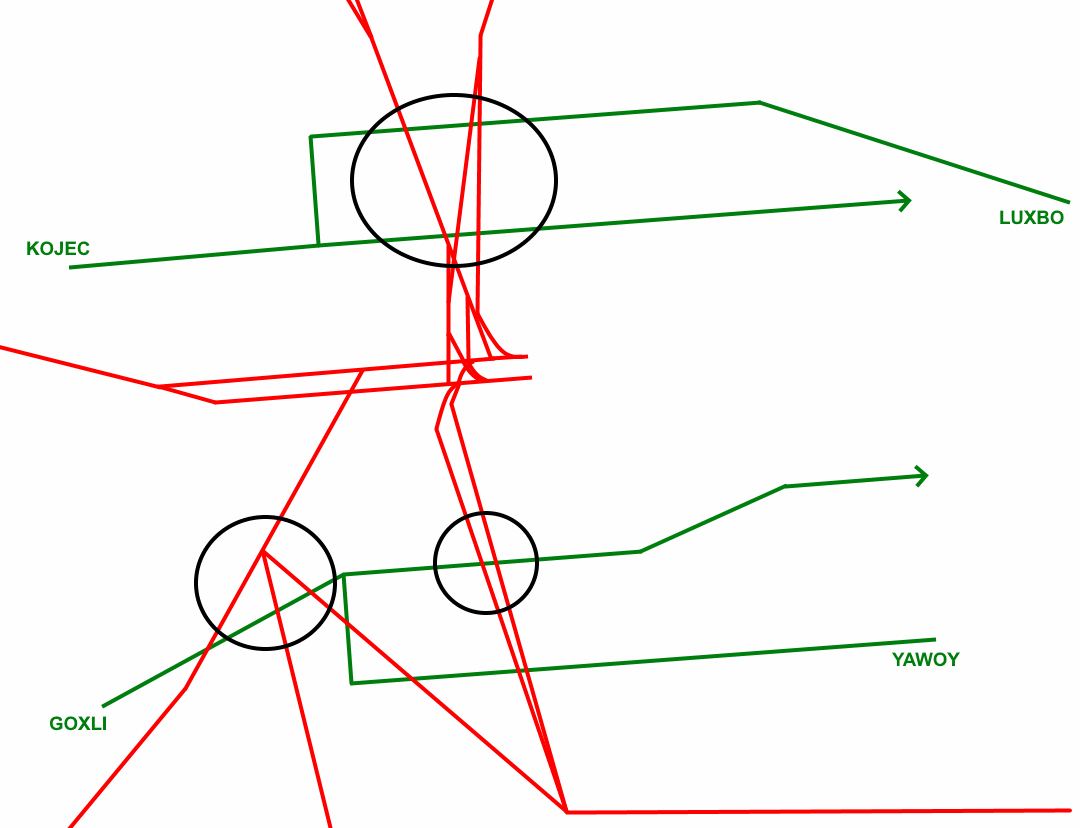](https://knowledgebase.vatsim-germany.org/uploads/images/gallery/2022-09/eddp-konflikte-26.png)Approach paths and conflicts at 26 operations
As can be seen, STARs and SIDs intersect in most cases. It is therefore important to ensure that separation between departing and arriving traffic is maintained at all times. The following altitudes are recommended on the STARs:
| **Position** | **Fluhgöhe** |
| Starting point of the STAR | FL110 |
| Upwind | FL100 |
| Downwind up to airport level | FL080 |
| Downwind from airport level | 5000ft |
It is possible to deviate from these altitudes, but it is important not to clear any aircraft below FL080 before the conflict point between the SID and STAR has been passed. The reason for this is the initial climb from FL070 on all departure routes.
Directs to the respective STAR are may made to waypoints DP424 and DP465.
After the aircraft have flown **past the last waypoint of the STAR**, the pilot is expected to **maintain the downwind track**. In this case, special attention must be paid to the MVA and the boundary to Berlin Arrival, especially during 26 operations. **Entry into this sector without coordination is not permitted**. It is the task of the arrival controllers to keep the downwind as short as possible. In reality, the utilisation of both runways is ensured during peak times.
#### Transitions
Leipzig/Halle Airport has CDA transitions (Continuous Descent Approach), which are available from the waypoints MAXEB, UPLEG and LIPVO. These transitions may only be used between 22:00 and 06:00 local time. However, they are not used very often.
#### Approach types
At Leipzig/Halle Airport, there are three published approach types for all runways. Leipzig has ILS, LOC and RNP approaches. If a visual approach needs to be cleared, the approach controller is obliged to inform the tower controller.
At night, the final approach must be at least at 11 NM for noise protection reasons (26: DP447/DP437, 08: DP442/DP432).
#### Operating mode
Independent parallel approaches are permitted in Leipzig. However, the primary operating mode is staggered. Every controller must familiarise themselves with the conditions of the respective operating mode in advance. Further information is available at the Tower-SOP. It is important to note that despite all conditions for IPA or staggered approaches, the MVA must be observed at all times!
#### Runway assignments
- Aircraft on the KOJEC, LUXBO arrival awaiting the northern runway
- Aircraft on GOXLI, YAWOY arrival awaiting the southern runway
- Aircraft parked on aprons 1 and 3 await the northern runway
- If traffic conditions permit, cargo aircraft land on the southern runway
- The A346/B77W/B744/B748/A388 aircraft types should be assigned to the southern runway
Depending on the traffic situation, deviations from these specifications are possible. However, the arrival determines the runway to be used by the aircraft in all cases. During high-traffic operations, it is recommended to send more aircraft to the northern runway, as the southern runway is heavily congested with departures due to cargo traffic.
#### Handover to arrival
The handover to arrival normally takes place at a speed of 220 kts. *If traffic conditions permit or require, aircraft may also be handed over at a higher or lower speed.*
Traffic on the downwind leg is normally handed over as shown below:
| **Downwind** | **RWY 08** | **RWY 26** |
| **North** | 5000ft | 4000ft |
| **South** | 4000ft | 5000ft |
Individual direct approaches can also be coordinated with the arrival.
#### Two Feeder Operations
Before opening the second arrival position, TRS, TRN and DPSD need to be staffed. The following procedures are necessary for two arrivals:
- Independent parallel approaches **shall** be used
- Independent Parallel Approaches need to fly an **ILS** approach **or**
- an **RNP** Approach **with vertical guidance** (LNAV-only is not authorized, this is desribed on the approach charts as well)
- Intercept headings need to be ≤ 30 degrees to the final approach track.
- 1 NM straight and level on the intercept heading,
- 2 NM straight and level on the final approach course
- The north arrival (F\_APP) receives aircraft for the northern runway
- The south arrival (U\_APP) receives aircraft for the southern runway
- The pickup determines the runway and transfers aircraft to the appropriate feeder
#### Application of RECAT-EU procedures
Leipzig is one of the airports at which the DFS approved the use of the RECAT-EU procedures.
**The use of them is only allowed for the category "Lower Heavy/Upper Heavy" and "Lower Heavy/Lower Heavy", these are the aircraft types: **
| ##### **Upper Heavy**
| ##### **Lower Heavy**
|
| **A330** | **A300** |
| **A340** | **A310** |
| **A350** | **B703** |
| **B747** | **B757** |
| **B777** | **B767** |
| **B787** | **B783** |
| **IL96** | **C135** |
|
| **DC10** |
|
| **DC85** |
|
| **IL76** |
|
| **MD11** |
|
| **TU22** |
|
| **TU95** |
According to the procedure 2 of the above aircraft types only have to be separated 3NM (wake turbulence) unless another method of separation (e.g. radar separation) requires more.
The pilot can refuse this procedure at any time, but shall inform you early.
Caution between Upper-Heavy and Lower-Heavy! The "Lower Heavy" must be preceding!
Mediums are excluded from this procedure!
#### Erfurt-Weimar
Aircraft are guided either via headings or the STAR. Clearance for the STAR is always given from Thüringen Süd Low. Here, particular attention must be paid to the convergence of traffic on the downwind and base legs. In addition, attention must be paid to VFR traffic, as the Erfurt TMZ area is very small and not every pilot is aware of the activity in this airspace. Furthermore, the MVA in Erfurt plays a not insignificant role. As soon as low visibility operations have to be used, approach direction 09 is no longer usable. Only the ILS on 27 up to CAT IIIb is permitted here.
### Overflights
The Thüringen Low sector is also responsible for some overflights due to its vertical boundary of FL195.
Further information can be found in the internal ATCISS.
### Holzdorf
The Holzdorf military airfield has an area of responsibility in which Holzdorf Radar can control aircraft when activated. Berlin Arrival South is obliged to inform München Radar about the activation/deactivation of Holzdorf.
All aircraft to/from Holzdorf must be individually coordinated between Bremen Radar/München Radar and Holzdorf Radar.
[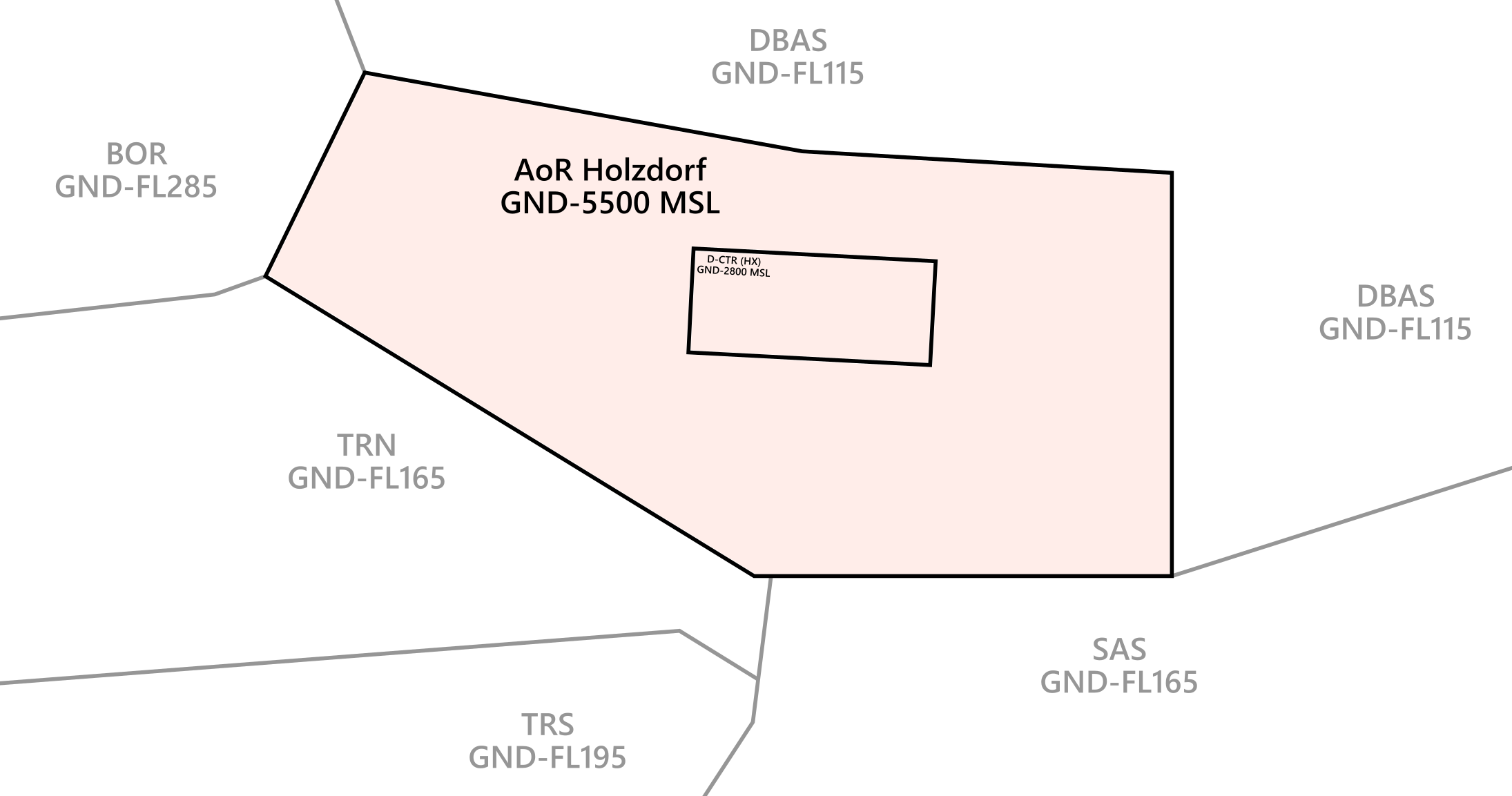](https://knowledgebase.vatsim-germany.org/uploads/images/gallery/2022-10/holzdorf-aor.png)
### Release Areas
#### TORGAU Area
- GND - FL105 (Wenn Holzdorf AoR aktiv: 5500 MSL - FL105)
- Delegation von DBAS an TRN/S
- Only EDDP Inbound RWY 26
Activation only possible upon request from TRN/S by DBAS
#### MULDE A Area
- FL135 - FL165/FL195
- Delegation von TRN/S an ACC Sector FLG
- For EDDB TMA Inbounds (earlier descent possible)
Activation only possible upon request from ACC Sector FLG via TRN/S
#### MULDE B Area
- FL165 - FL195
- Delegation von TRN/S an ACC Sector FLG
- For EDDB TMA Inbounds (earlier descent possible)
Activation only possible upon request from ACC Sector FLG via TRN/S
[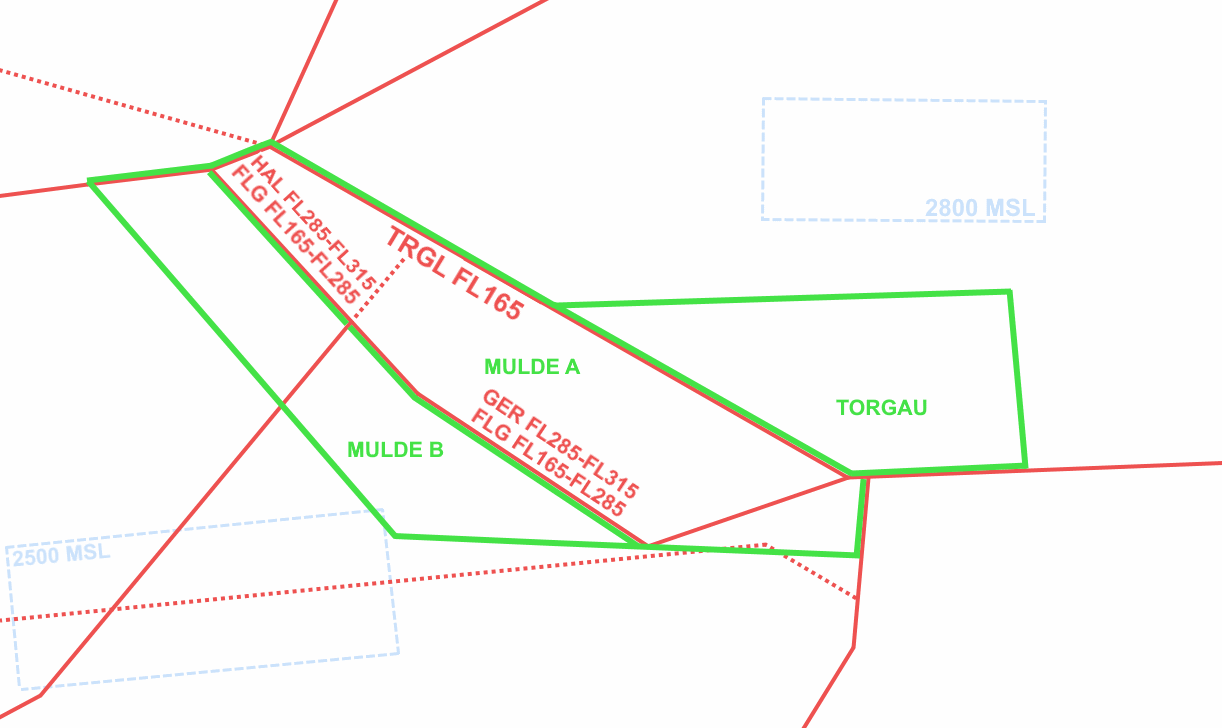](https://knowledgebase.vatsim-germany.org/uploads/images/gallery/2022-09/mulde-torgau-area.png)*MULDE A,B Area, Torgau Area*